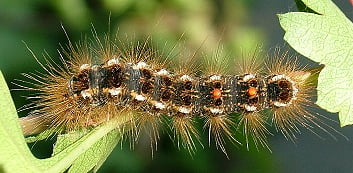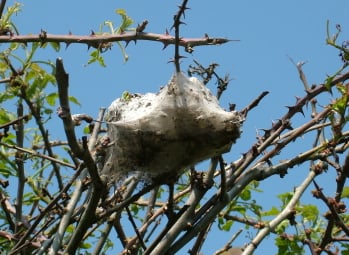Brown-Tail Moth – (Euproctis Chrysorrhoea).
The Brown-Tail Moth has been found in Great Britain since the early 18th Century and primarily inhabits coastal regions. Although generally uncommon, isolated populations have been identified on the Isle of Wight.
Due to the potential health risks landowners may have to pay for the treatment. The Isle of Wight Council enforces the Prevention of Damage by Pests Act 1949 and does not provide a pest control service.
Click here for a list of the Council’s Approved Pest Control Contractors
If in doubt telephone your local Environmental Health Department.
Tel: 01983 823000.
Tel: 01983 823000.
How to determine the moth:

Below is a photograph of the caterpillar.

What to look for:
The caterpillars emerge from silk cocoons in spring to eat before pupating and hatching as adult moths in early to mid- Summer.
The adult moth survives for about five days during which
it lays eggs in clusters typically on leaves of Blackthorn
and Hawthorn.
The egg cluster is enveloped by a layer of hairs for protection from birds etc. These hairs which are also
found on the caterpillar and adult moth can cause
irritation when in contact with the skin which can lead
to quite a severe rash.
Susceptibility to the hairs varies considerably from person
to person but reactions may be more pronounced in
persons suffering from Asthma, Eczema and other
sensitive conditions.
Treatment of those affected can include Calamine lotion
or anti-histamine cream.
The adult moth survives for about five days during which
it lays eggs in clusters typically on leaves of Blackthorn
and Hawthorn.
The egg cluster is enveloped by a layer of hairs for protection from birds etc. These hairs which are also
found on the caterpillar and adult moth can cause
irritation when in contact with the skin which can lead
to quite a severe rash.
Susceptibility to the hairs varies considerably from person
to person but reactions may be more pronounced in
persons suffering from Asthma, Eczema and other
sensitive conditions.
Treatment of those affected can include Calamine lotion
or anti-histamine cream.
In more severe cases
you should seek medical advice.
Below is a photograph of the Silk Web (Tent).

TREATMENT.
The landowner may have to pay for the treatment. A water-based insecticide may be used for the treatment which relies on contact with the caterpillar and is most effective during the spring.
Winter pruning is also effective when the caterpillars are inactive in their silk webs – see photograph. The branches holding the caterpillars can be pruned and destroyed and it is recommended that gloves are worn when carrying this out.
Treatments will only be successful if carried out on all affected premises at the same time. Unwillingness to participate can reduce the success of treatment.
Winter pruning is also effective when the caterpillars are inactive in their silk webs – see photograph. The branches holding the caterpillars can be pruned and destroyed and it is recommended that gloves are worn when carrying this out.
Treatments will only be successful if carried out on all affected premises at the same time. Unwillingness to participate can reduce the success of treatment.
For more information regarding this Leaflet please contact:
Environmental Health Service
Jubilee Stores
The Quay
Newport
Isle of Wight
PO30 2EH
Telephone: 01983 823000
Facsimile: 01983 529804
©Isle of Wight Council, May 2004
Page last updated on: 30/08/2007





